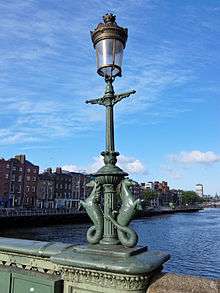Grattan Bridge
| Grattan Bridge Droichead Grattan | |
|---|---|
|
| |
| Coordinates | 53°20′45″N 6°16′04″W / 53.3457°N 6.2678°WCoordinates: 53°20′45″N 6°16′04″W / 53.3457°N 6.2678°W |
| Crosses | River Liffey |
| Locale | Dublin |
| Preceded by |
Built 1676 - Essex Bridge Rebuilt 1753 - Essex Bridge Rebuilt 1872 - Grattan Bridge |
| Characteristics | |
| Material | Stone, iron |
| No. of spans | 5 (2 semicircular & 3 elliptical arches) |
| History | |
| Designer | George Semple (1750s build). B.B. Stoney & P. Neville (1870s widening)[1] |
 Grattan Bridge Location in Central Dublin | |

Grattan Bridge (Irish: Droichead Grattan)[2] is a road bridge spanning the River Liffey in Dublin, Ireland, and joining Capel Street to Parliament Street and the south quays.
History
The first bridge on this site was built by Sir Humphrey Jervis[3] as Essex Bridge (named for Arthur Capell, 1st Earl of Essex, Lord Lieutenant of Ireland) to join several of Jervis' developments (including Capel Street and Jervis Street) to the opposite side of the river and to Dublin Castle. Essex Bridge was an arched stone structure with 7 piers, and apparently partly constructed from the ruined masonry of nearby St. Mary’s Abbey on the northside.[1] In 1687 the bridge was damaged by a flood resulting in the loss of a hackney and two horses. The damage to the bridge was only partially repaired.[4]
In 1751 the second most northerly pier collapsed and damaged the adjacent arches.[1] Between 1753 and 1755 the bridge was rebuilt by George Semple, to correct flood and other structural damage and as one of the first initiatives of the Wide Streets Commission.[1] During this construction, some original features were removed, including the Equestrian Statue Of George I, by John van Nost the Elder,[5] which was moved in 1798 to the gardens of the Mansion House. In 1937 it was bought by the Barber Institute for Fine Arts in Birmingham, in front of which it now stands.[5] For much of the 18th century, Essex Bridge was the most westerly bridge on the Liffey.[6]
From 1872, the bridge was further remodelled (on Westminster Bridge in London), being widened and flattened with cast iron supports extended out from the stonework so as to carry pavements on either side of the roadway.[1] The bridge was (and is still) lit by ornate lamp standards also in cast iron.[3]
The bridge was reopened as Grattan Bridge in 1874, being named after Henry Grattan MP (1746-1820).
Recent development
In 2003/2004 the Dublin City Council, planned and built what was intended to be a "European-style book market" on Grattan Bridge. The initiative included reconstruction of the bridge deck, with granite paving for the footpaths and a set of benches with wooden seats and toughened glass backs.
Following this development, several temporary kiosks (prefabricated in Spain) were controversially built on the bridge, to create "a contemporary version of an inhabited bridge, such as the Ponte Vecchio in Florence".[7] These kiosks have since been removed.[8]
Nomenclature
As is tradition among Dubliners, the name used locally for the bridge will vary from Capel Street Bridge, to Grattan Bridge and the original Essex Bridge.
References
- 1 2 3 4 5 Project history of Dublin's River Liffey bridges (PDF). Bridge Engineering 156 Issue BE4 (Report). Phillips & Hamilton. p. 162.
- ↑ "Droichead Grattan / Grattan Bridge". Logainm.ie. Irish Placenames Commission. Retrieved 8 December 2016.
- 1 2 "Grattan Bridge, Dublin". Archiseek. 2010. Retrieved 8 December 2016.
- ↑ Lennon, Colm, and Montague, John (2010). John Roque's Dublin: A guide to the Georgian City. Dublin: Royal Irish Academy.
- 1 2 De Courcy, John (1988). Anna Liffey. The river of Dublin. Dublin: O'Brien Press.
- ↑ "Local History - Temple Bar". Templebardoc.com. Archived from the original on 30 December 2006.
- ↑ "Liffey kiosks are 'visual vandalism', council told". Irish Times. 13 February 2004.
- ↑ "Grattan Bridge kiosks gone". Irish Times. 3 April 2008.